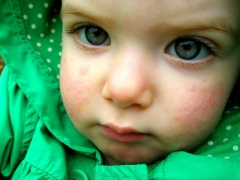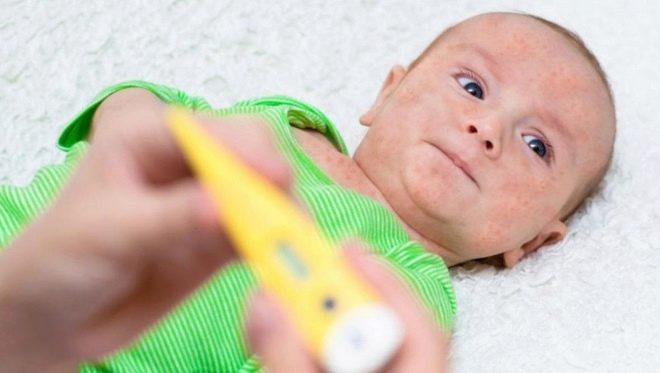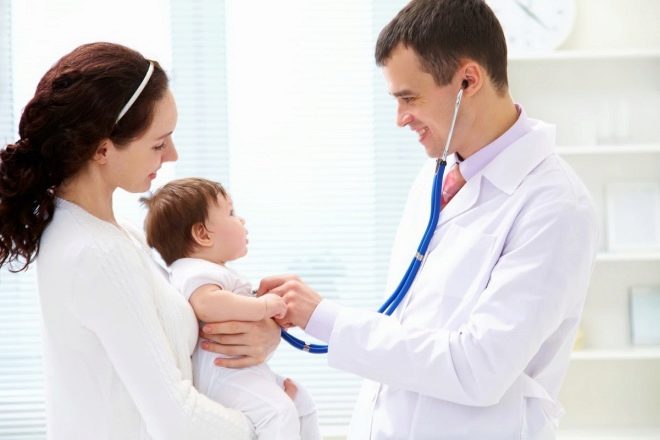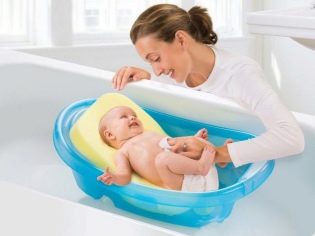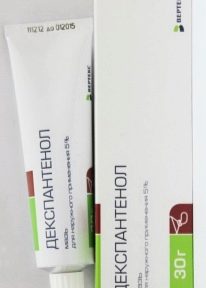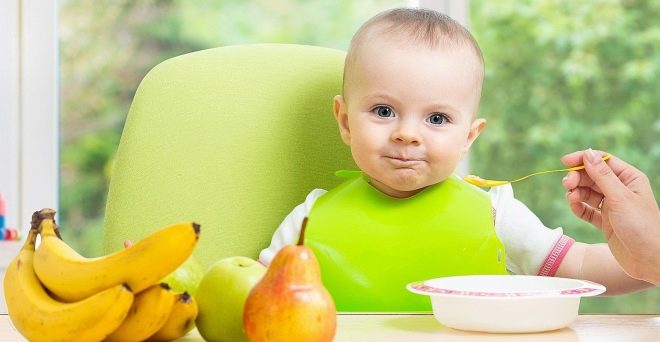What if there is a rash on the face of a child?
A rash on the face in children of different ages appears with enviable regularity. Its types are different, as well as the reasons for which rashes appeared. To understand what to do in a given situation, you should first try to understand what led to skin rashes. On the most common causes of facial rash, we will discuss in this article.
Age features of the skin
Children's skin, to a greater extent than adult, is subject to negative influence from the outside, rashes are much more often formed on it. At birth, the baby's skin is several times thinner than the skin of adults, they are more intensively supplied with blood, the vessels and capillaries are located close to the surface, which is why the skin of the baby looks more red.
An additional protection for the baby’s skin is provided by the “lipid mantle” - a fatty layer that covers the skin with a thin invisible film. However, this “mantle” is not given by nature forever, and within a few days or weeks after birth, it becomes thinner and almost disappears. The kid is almost defenseless from outside threats, because his local immunity is still very weak.
The sebaceous glands of infants and newborns do not work well, their ducts are narrow, the sweat glands produce sweat, but their discharge is also hampered by narrow ducts. All this creates suitable conditions for the emergence of a rash of one type or another.
Only by 5-6 years old, the child’s skin becomes rather dense.similar to the adult in the proportions of the layers and subcutaneous fatty tissue. Usually by this age the number of sudden and difficult to explain pimples, wheal and redness is significantly reduced.
On the face and head, rashes at an early age appear most often. And indeed, babies whose thermoregulation center is not yet debugged, intensively give off excess heat through the scalp. That is why often prickly heat begins with the face and scalp. With a rash on the face, babies can react to the introduction of complementary foods if the new food has caused an allergic reaction. Baby is covered with rash during an infectious disease.
To provoke the appearance of rashes can any external or internal factor. To external include dryness or high humidity, heat or hypothermia, pollution, rough, unpleasant linen, which comes into contact with the baby. Internal factors are an allergic reaction, a children's infectious disease, dermatological diseases.
The rash itself can also be different, and an understanding of what kind of rash appeared on the child’s face, will help parents to guess the true causes of the symptom:
- Erythema. By and large, this is not a rash, just reddening of the skin on a certain area. Peculiar to allergic reactions, burns, toxic lesions.
- Tubercles. Such a rash is not superficial, it is only a slight elevation of the skin in a certain place, may be accompanied by erythema (redness).
- Blister. It is a rash, like a nettle burn.It is an elevation, swelling. There is a short time, and, as a rule, disappears as suddenly as it appeared. Peculiar to some types of burns and contact allergies.
- Papules This is a nodular rash, each element of which resembles a small nodule, which is different in color from other healthy skin. It may be a symptom of allergies, infections, and hormonal adjustment.
- Vesicles. These are bubbles on the skin that can blend together. Inside the vesicle is serous fluid or serous-hemorrhagic contents. They burst easily, leaving eczema on the skin. Such a rash can appear in infectious diseases, in atopic dermatitiswith some allergic reactions.
- Pustules These are pustules, which are superficial and deep. They may appear in infections, mainly of bacterial origin, may be a complication of an allergic or other rash, often "signal" about violation of hygienic rules.
- Stains. This type of skin changes (petechial rash) can be a sign of allergies, metabolic problems.
- Hemorrhagic points. This is usually a punctate rash, which is a burst of small capillaries inside the skin layers. Often accompanied by childhood infectious diseases.
Causes of
Consider the main reasons that cause a rash on the face in children.
Non-infectious
The microclimate in which the child lives or stays for a long time can affect the skin condition. If the air is dry, the room is hot, then the skin very quickly becomes dehydrated, the skin becomes dry, and micro cracks are faster on it, through which infection occurs. Such skin is more susceptible to local effects, an allergic reaction occurs faster on it.
A child who eats few foods containing vitamins E and A is also at risk, because these two vitamins are responsible for the elasticity of the skin. The small amount of fluid you drink is also a factor that makes the skin more dry and vulnerable.
Violation of temperature often leads to the formation of hemorrhage and diaper rash. Hormonal background can also affect the work of the sebaceous and sweat glands, which can lead to the formation of rashes on the face of the child.
Atopic dermatitis
Such a rash appears in children with certain genetic background to an allergic reaction. Usually there are several factors that lead to sensitization of the body. This is the simultaneous effect of heat and allergens., which are part of, for example, washing powder, which is used by parents for washing children's clothing and bed linen.
A rash can have a varied appearance, type and geography. If it appeared on the face, then you should carefully examine the remaining skin, since such dermatitis tends to spread to other parts of the body - the folds of the arms and legs, the groin area.
Allergy
Allergic dermatitis - This is an external manifestation of the internal process in which the immune system diligently tries to cope with protein-antigens (allergens). A rash occurs after contact with an allergen, sometimes a delayed reaction - rashes appear a few days after taking allergenic food, medication, contact with plant pollen or animal hair.
Allergies can only affect the area of the face, and can spread to any other part of the body. An allergy rash usually begins with separate scattered elements on the cheeks or forehead, and then the individual elements merge into more extensive formations, the surface of which prone to flaking.
Allergies usually occur without temperature, but there are exceptions. However, high heat during an allergic reaction does not happen.There may be respiratory symptoms - nasal congestion, cough, allergic conjunctivitis.
Allergic rash itches and gives the child an unpleasant feeling.
Prickly heat
Rarely, rash from prickly heat affects only the face. Usually red rashes are found both in the scalp, on the neck, in the folds of the arms and legs, as well as in the diaper area. Unlike allergic, prickly heat is not prone to expansion of the affected areas, it quickly passes when exposed to fresh air. Like allergic, this rash not accompanied by additional symptomshowever, sometimes with the formation of strong diaper rash and weeping eczemas, the child may experience pain and begin to worry.
Neonatal pustus
This phenomenon occurs only in newborns and children of the first two months of life. Whitish or yellowish pimples - pustules appear on the cheeks, forehead, nose, chin, on the ears, behind the ears under the influence of hormones. After the baby is born into the body, a rather impressive amount of mother’s sex hormones, estrogens, are actively produced in the last weeks of pregnancy to ensure normal labor.
The content of these hormones in the children's body gradually decreases, as the hormonal background normalizes, the skin integuments come into order, and the pimples disappear. And while there are estrogen, it causes intensive work of the sebaceous glands, the ducts of which are quickly clogged.
So acne appears. By the way, the mechanism of development of acne in adolescents is similar to the neonatal one, only in the pubertal period, the sebaceous glands are no longer influenced by maternal hormones, but by the sex hormones of a young man or girl.
Infectious
There are a lot of diseases that are accompanied by rashes on the face. In childhood, it can be scarlet fever, chicken pox, and baby roseola, and rubellaand measles and mononucleosis. The hallmark of an infectious rash is the presence of other symptoms. A rash with infections usually does not appear immediately, a day or more after the onset of the disease.
If the child is sick, he has a fever, signs of intoxication appeared, and the next day or a couple of days later a rash appeared on his face, then there is no doubt that the rash has an infectious origin. In itself, an infectious rash has a fairly clear shape, is not prone to fusion, is widespread throughout the body, sometimes covers the entire child.
Meningococcal infection
On the background of high fever and other symptoms of meningococcal lesions, the skin becomes pale, almost earthy. The rash never "starts" from the face. It starts on the buttocks, legs, goes to the body and only after that can appear on the face and even affect the eyeballs. A hemorrhagic rash looks like red spider veins.
With a non-dangerous course of the disease, points rarely appear on the face. When it comes to this, it is considered an unfavorable symptom, indicating a serious course of the disease and possible complications.
Rubella
A rash on the face is one of the first symptoms of rubella. Viral rashes begin from this part of the body. After that, the rash covers the entire body, bypassing only the palms and feet. Rubella is characterized by pinkish rashes that do not protrude above the level of the skin, almost never merging into a single spot. Usually, such a rash disappears after four days during normal course of the disease and does not leave any traces on the skin.
Chickenpox
With this common childhood disease of infectious viral nature, the rash simultaneously covers not only the skin of the face, but also the head, neck, arms, chest, abdomen, and legs. The rashes themselves are heterogeneous. Some elements may be vesicles (bubbles with liquid), others are already moving on to another stage - crusts.The disease occurs on the background of elevated temperature, it may be a slight itching, especially at the stage following the burst vesicles.
In no case should the peels be removed and combed., it can leave marks, cosmetic defects on the face for the rest of life. The type of rash on chickenpox varies daily.
Children's roseola
Sudden children's rash begins usually after three days of high fever. It causes herpes virus disease, which is akin to chickenpox, but has a different type. In case of roseola, the skin of the child throughout the body, including the face, eyebrows, scalp, almost simultaneously, suddenly becomes covered with pink spots, without purulent heads, without blisters.
The rash disappears as suddenly as it appeared, usually it occurs 5-6 days after its occurrence.
Measles
Rash measles it appears on the 4-5th day of the disease and it always begins with the area of the ears, ear space, side surfaces of the cheeks. Pink spots without pustules and vesicles spread to the face quickly enough. During the day, the elements cover the skin not only of the neck and face, but also of the arms, shoulders and sternum. The spotted rash is gradually transformed into papules, which can merge with each other.
By the way, only this sign allows us to distinguish measles from rubella. The spread of the rash lasts about three days. By the end of this period, the first elements that appear on her face begin to turn pale, she begins to peel off and gradually disappears.
Diagnostics
If a rash on the face appeared in a child under one year old, it should be urgently shown to the doctor, since all infectious diseases in children of this age are more severe, and the allergic rash also needs treatment.
In children older than one year, the diagnosis should also begin with a visit to the doctor. The doctor will carefully examine the history of the child, find out what ailments he was ill, from what diseases he was vaccinated. Mom will need to remember in as much detail as possible that over the past three days the baby has been eating and drinking, which new food has been introduced.
Sometimes the cause of an allergic rash may even be a new toy bought by parents, if it is made of low-quality materials.
In most cases, the nature and type of rash doctor quickly establishes its origin. In doubtful cases, additional tests are prescribed - blood, urine, feces. Sometimes, if a bacterial infection is suspected, they can take samples of the contents of the pustules on bacperosis in order to establish the type of pathogen and its resistance to certain types of antibiotics.
Diagnostic table:
Disease | Character of rash | Other symptoms |
Allergy | Pink, red, colorless, flesh-colored rash in the form of spots, without vesicles and pustules | Itching, possible runny nose, cough, headaches |
Papules, blemishes, eczema formation | Itching, headache, respiratory symptoms | |
Neonatal pustular disease | White, yellow acne, surface, without signs of inflammation | Absent |
Prickly heat | Red, fine with erythema, weeping with the formation of a crust | Missing or weak pain syndrome |
Chickenpox | Mixed - vesicles and papules, does not merge | Fever, cough, runny nose, intoxication, headache |
Pink spots | Temperature, intoxication, muscle pain | |
Rubella | Pink and red spots not rising above the skin | Temperature, headache, muscle, joint pain, intoxication |
Meningococcal infection | Red small spots "asterisks", bright vascular points | Fever, muscle aches, intoxication, cough, runny nose, nausea |
Acne | Pustules and papules that are not prone to merging | Absent |
What to do when detected?
When detecting a rash in a child's face, it is important to correctly assess the situation. To do this, parents need to understand whether a baby has an infectious or non-infectious rash in order to choose a tactic of action.When an infectious disease should call a doctor from the clinic. If it is accompanied by a temperature above 39.0 degrees, then you should call an ambulance. If the rash is presumably non-infectious, you can go to the doctor yourself.
To assess the situation, it is important to know:
- What the child ate or drank. We need to remember all the new products that the baby tried, all the drinks. If the baby is breastfed, it is important to remember everything that the nursing mother used to eat. It is important to understand which allergen could cause an inadequate response of the body.
- Than the child played with what had contact. If a baby has a new toy, clothes, mom used a new brand of washing powder or detergent, and a few days later a rash appeared on his face, it is quite possible that the reason lies in this “new” one.
- In what conditions the child lives. It is necessary to find out what is the temperature of the air in the apartment, where the baby is growing, and what is the relative humidity of the air. The optimal values are as follows: temperature - 18-21 degrees of heat, humidity - 50-70%. The hotter the room, the drier the air in it.
- Like a baby dressed. If the baby is being muffled up, if he is hot, then sweating increases and the risk of development of prickly heat, atopic dermatitis, and an allergic reaction increases. The baby can check the back of the head in a dream - if he does not sweat, then the child is dressed properly.
- Do they properly care for baby's skin? Washing rarely is harmful. But washing is often not less dangerous, especially if parents use soap every time for washing. Detergents dry the skin, so excessive hygiene also leads to the formation of skin rashes.
- Is the kid sick? Having found a rash on the face, you need to examine the rest of the body, measure the child's body temperature, examine its throat, and see if the nose is breathing. If the temperature is elevated and there are other symptoms of the disease, then there is a chance that the rash is associated with infection.
Treatment
Despite a fairly large list of possible causes of facial rash, treatment in cases not related to infection may be much easier task than it seems to parents. First you need to eliminate the cause that caused the rash.
If it is an allergy, then the child should be protected from contact with the allergen. All his clothes and bedding should be washed only with special hypoallergenic children's products, and after washing it is necessary to additionally rinse with clean water. Special attention should be paid to the diet of the child, it should not be anything potentially dangerous.
If the child at this moment takes any medication, you should definitely inform the doctor about it and if it is impossible to cancel the drugs and choose analogues.
Humidifying the air, maintaining the correct temperature will help to save the child not only from hemorrhage, but also from most types of rash, because the allergic reaction develops faster and is more difficult if you do not follow the simple rules for maintaining the correct indoor climate.
It is not necessary to bathe and wash the child with a rash on the face with hot water, it is better to do it with warm water without soap. You can wash the baby broth pharmacy chamomile.
In 80% of cases, these measures are more than enough for a non-infectious rash to first turn pale, and then completely disappear without a trace.
However, sometimes without treatment can not do. Allergic rash may require therapy. antihistamine drugs ("Suprastinom", "Tavegilom», «Loratadine», «Tsetrinom"And others) as well hormonal ointments («Advantan"," Triderm "). Such treatment is not always prescribed, and not all, the decision on the use of such drugs must be taken by a doctor.
Neonatal rash in newborns does not need treatment at all, as it passes by itself as the level of maternal hormones decreases. For prickly heat, correction is required both of the microclimate in the apartment and of the hygienic principles and approaches that exist in the family.Air baths, bathing without soap with a decoction of a string, chamomile, treatment of weeping diaper rash with baby powder or drying cream («Sudokrem"), And dry crusts - softening creams with a healing effect, eg, "Bepantenom" or "Dexpanthenol».
If the rash is itchy, then should not be combedbecause it increases the risk of attaching a secondary infection. It is necessary to ensure that the child has comfortable clothes, soft bedding, in order to avoid additional mechanical irritation.
If the rash has increased on one cheek from the side on which the baby slept, then this may indicate that the child sleeps on linen, which is washed with allergenic substances or irritates the skin mechanically.
Infectious rash treatment is by and large not necessary. It passes as the child recovers from the underlying disease. It is only important not to allow scratching, as well as to treat those fragments of rash with an antiseptic that the child still managed to comb to avoid bacterial contamination. For processing suitable aniline dyes - "Zelenka" or "Fukortsin"As well as the drug" Chlorophyllipt. "
What can not be done?
When a rash of any nature occurs, the following actions are prohibited:
- You can not squeeze and independently open in other ways the elements of skin rashes on the face of a child. This can cause the accession of a bacterial or fungal infection, as well as ugly scars and facial scars, which can then be removed only with the help of plastic surgery and cosmetology.
- You can not lubricate the child rash on the face with alcohol, vodka, alcohol-containing lotions or other liquids.
- You can not lubricate the rash baby cream, as well as other means that have a fatty basis. Under the film of such substances, the "breathing" of the skin is broken, the rash may increase.
- You can not self-medicate.
Prevention
A rash on the face of the baby, as well as on the legs, arms and other parts of the body will be unlikely if the parents adhere to certain preventive rules:
- All age-adjusted vaccinations must be made on time, as they protect the baby from the most dangerous childhood infections.
- At high temperatures during illness you should not give your baby too much sweet syrups and antipyretic drugs. It is better to use other dosage forms, for example, rectal suppositories.
After all, a rash on the face like an allergy to drugs often enough occurs during the period of the disease, since the immunity is weakened.
- Hygienic mistakes should be avoided - do not wash the child too often with soap, but also not forget about the necessary minimum. Washing the child with hot water is not worth it.
- Children after 1 year old who are beginning to move actively around the apartment should not have access to chemicals, acids, alkalis, detergents that parents use in the household.
- Littering a child under one year should be introduced with caution, without violating the terms and rules.
- Children who attend kindergarten (4-6 years old) should be taught to touch their face as little as possible.
All about the causes of a rash on the face of a child, see the following video.
